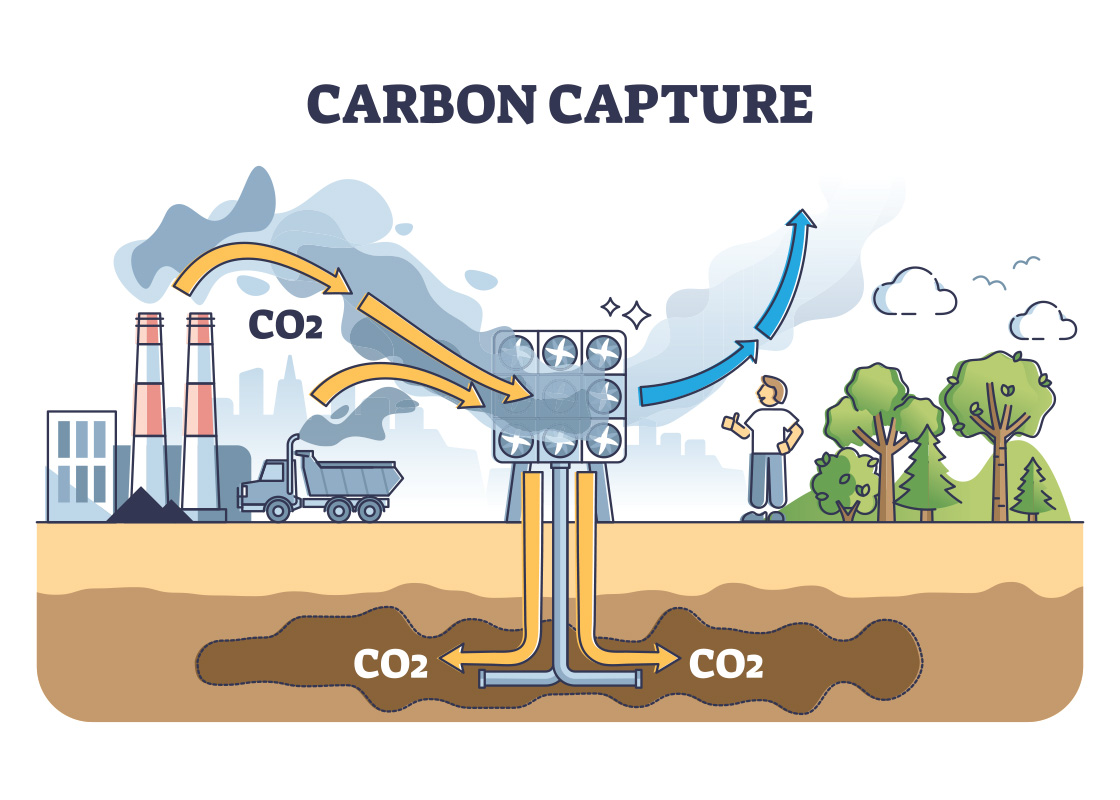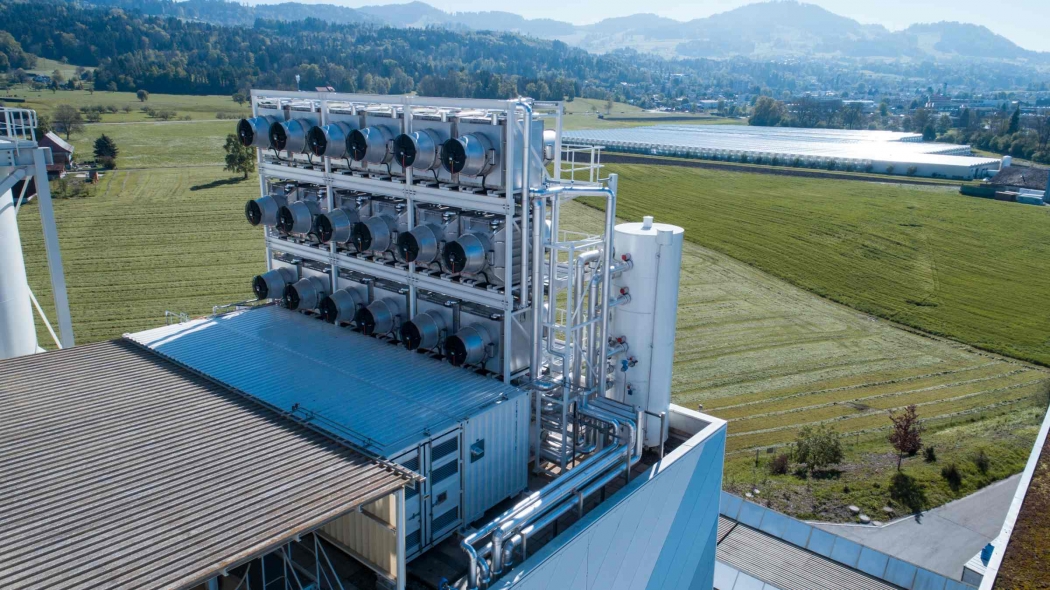
Exploring the Benefits of Carbon Capture for a Sustainable Future
Published by Todd Bush on June 15, 2023
As the world continues to grapple with the impacts of climate change, there has been increasing concern about the need to find sustainable solutions. One technology that has gained traction in recent years is carbon capture. Carbon capture refers to the process of capturing carbon dioxide (CO2) emissions from power plants and other industrial processes and storing them underground or using them for other purposes. This article explores the benefits of carbon capture, including its environmental and economic advantages, and its role in combating climate change.
>> In Other News: Carbon TerraVault’s California DAC Hub Consortium Selected for U.S. DOE Funding to Bring Direct Air Capture and Storage to the Golden State
Understanding Carbon Capture Technology
What is Carbon Capture?
Carbon capture technology involves capturing CO2 emissions from industrial sources and storing them underground or repurposing them for other uses. The goal is to prevent these emissions from entering the atmosphere and contributing to climate change.
Carbon capture technology is an important tool in the fight against climate change. It allows us to continue using fossil fuels while reducing their impact on the environment. By capturing and storing CO2 emissions, we can significantly reduce the amount of greenhouse gases that enter the atmosphere.
Types of Carbon Capture Methods
There are three main types of carbon capture methods: post-combustion, pre-combustion, and oxy-fuel combustion. Post-combustion involves capturing CO2 emissions after combustion has occurred. Pre-combustion involves capturing CO2 before combustion, while oxy-fuel combustion involves burning fuel in pure oxygen, which produces almost pure CO2 emissions that can be captured more easily.
Post-combustion carbon capture is the most commonly used method, as it can be retrofitted onto existing power plants and industrial facilities. Pre-combustion carbon capture is often used in new power plants, while oxy-fuel combustion is still in the experimental stage.

Each type of carbon capture method has its own advantages and disadvantages. Post-combustion is the most widely used, but it is also the most energy-intensive. Pre-combustion is more energy-efficient, but it requires more complex technology. Oxy-fuel combustion is still in the experimental stage and has not yet been widely adopted.
The Science Behind Carbon Capture
Carbon capture works by using chemical reactions to separate CO2 from other gases. The separated CO2 is then compressed and transported to a storage site. There, it can be stored underground, where it will remain for thousands of years. Alternatively, the CO2 can be used for other purposes, such as enhanced oil recovery or in the production of fuel or other chemicals.
Carbon capture technology is constantly evolving, with researchers and engineers working to improve its efficiency and reduce its cost. One area of research is the development of new materials that can more effectively capture CO2. Another area of research is the development of new storage methods, such as using CO2 to create building materials or storing it in deep ocean sediments.
Despite the challenges and limitations of carbon capture technology, it has the potential to play a significant role in reducing greenhouse gas emissions and mitigating the effects of climate change. As the technology continues to improve, we may see more widespread adoption of carbon capture in the coming years.
The Role of Carbon Capture in Combating Climate Change
Climate change is one of the most pressing issues facing the world today. As global temperatures continue to rise, the impacts of climate change are becoming increasingly severe. From more frequent and intense heatwaves to rising sea levels and more frequent natural disasters, the effects of climate change are being felt around the world.
Carbon capture is one technology that has the potential to play a significant role in combating climate change. By capturing CO2 emissions before they can enter the atmosphere, carbon capture can help to lower the amount of heat-trapping gases in the atmosphere, slowing the pace of global warming.
Reducing Greenhouse Gas Emissions
One of the primary benefits of carbon capture is its ability to reduce greenhouse gas emissions. The process involves capturing CO2 from industrial processes, such as power plants, and storing it underground or using it for other purposes. This means that less CO2 is released into the atmosphere, where it can contribute to global warming.
Carbon capture can be particularly effective in reducing emissions from industries that are difficult to decarbonize, such as cement and steel production. These industries are responsible for a significant portion of global greenhouse gas emissions, and finding ways to reduce their emissions is critical to addressing climate change.

Supporting the Transition to Renewable Energy
Carbon capture can also play a role in supporting the transition to renewable energy sources. While renewable energy sources like wind and solar are becoming more prevalent, many countries still rely heavily on fossil fuels for electricity generation. Carbon capture can help bridge the gap by making these traditional sources of energy cleaner and more sustainable.
For example, carbon capture can be used in conjunction with bioenergy, a renewable energy source that involves burning organic matter like wood or agricultural waste to generate electricity. By capturing the CO2 emissions from bioenergy, carbon capture can help to make this renewable energy source even more sustainable.
Enhancing Natural Carbon Sinks
In addition to reducing greenhouse gas emissions, carbon capture can also enhance natural carbon sinks like forests and oceans. Carbon sinks are natural processes that absorb and store carbon from the atmosphere, helping to mitigate the effects of climate change.
By reducing the amount of CO2 in the atmosphere, carbon capture technology can help to strengthen these natural carbon sinks and promote greater carbon sequestration. This can be particularly important in areas like tropical forests, which are highly effective at absorbing carbon but are under threat from deforestation and other human activities.
Overall, carbon capture is a promising technology that has the potential to play a significant role in addressing climate change. By reducing greenhouse gas emissions, supporting the transition to renewable energy, and enhancing natural carbon sinks, carbon capture can help to mitigate the impacts of climate change and create a more sustainable future.

Economic Benefits of Carbon Capture
Carbon capture technology has the potential to bring about significant economic benefits. It can create new jobs, promote industry growth, and generate new revenue streams. Furthermore, carbon capture can encourage further investment in clean technologies, which can help to create a more sustainable and resilient energy sector for the future.
Job Creation and Industry Growth
One of the key economic benefits of carbon capture is its potential to create new jobs and promote industry growth. Carbon capture infrastructure requires significant investment, which can stimulate economic growth in the short term. This investment can lead to the development of new technologies, the creation of new jobs, and the growth of related industries.In addition, the implementation of carbon capture technology can create jobs in a variety of fields, including engineering, construction, and operations. This can help to boost local economies and provide new employment opportunities for workers.
Potential for Revenue Generation
Carbon capture can also create new revenue streams. Captured CO2 can be sold to companies for use in the production of fuels or other chemicals. Alternatively, it can be used for enhanced oil recovery, which involves injecting CO2 into older oil wells to extract more oil. This revenue can help to offset the cost of carbon capture infrastructure and make it more economically viable. In addition, the sale of captured CO2 can help to reduce emissions in other industries, such as the production of cement and steel.
Encouraging Investment in Clean Technologies
Finally, carbon capture can encourage further investment in clean technologies. By promoting the development of carbon capture infrastructure and other clean technologies, governments and businesses can help to create a more sustainable and resilient energy sector for the future.This can lead to the creation of new industries and jobs, as well as the development of new technologies that can help to reduce greenhouse gas emissions. By investing in clean technologies, we can help to create a more sustainable and prosperous future for ourselves and future generations.In conclusion, the economic benefits of carbon capture are significant. It can create new jobs, promote industry growth, generate new revenue streams, and encourage further investment in clean technologies. By investing in carbon capture infrastructure and other clean technologies, we can help to create a more sustainable and resilient energy sector for the future.
Environmental and Social Advantages
Preservation of Ecosystems and Biodiversity
Carbon capture can help to preserve ecosystems and biodiversity by reducing the amount of CO2 in the atmosphere. This can help to slow the pace of climate change and mitigate its impacts, including those on wildlife and other natural resources.
Improved Air Quality and Public Health
Carbon capture can also improve air quality and public health. By reducing the amount of pollutants emitted by power plants and other industrial processes, carbon capture technology can help to lower levels of particulate matter and other harmful substances in the air, which can have significant health benefits for nearby communities.
Promoting Environmental Justice and Equity
Finally, carbon capture can help to promote environmental justice and equity. By reducing the amount of pollution emitted by industrial sources, carbon capture can help to protect communities that are disproportionately impacted by pollution and other environmental hazards.
Conclusion
Carbon capture technology offers a range of benefits for a sustainable future, including its ability to reduce greenhouse gas emissions, promote industry growth, and enhance natural carbon sinks. While there are certainly challenges associated with developing and implementing carbon capture infrastructure, the potential benefits are undeniable. By encouraging investment in this technology, governments and businesses can help to create a more sustainable and resilient energy sector for the future.
Subscribe to the newsletter
Daily decarbonization data and news delivered to your inbox
Follow the money flow of climate, technology, and energy investments to uncover new opportunities and jobs.
Companies
-
Cemex SAB de CV
CX
-
CF Industries Holdings
CF
-
Chevron
CVX
-
Williams Companies Inc.
WMB
-
Occidental Petroleum Corporation
OXY
-

SLB
SLB
-
ExxonMobil
XOM
Latest issues
-
North America’s Carbon Removal Year in Review: Winners, Losers, Surprises
Inside This Issue 🌎 North America's Carbon Removal Year in Review: The Deals, Policies, and Milestones That Shaped 2025 🚢 Hapag-Lloyd And North Sea Container Line Win ZEMBA Second E-Fuel Tender 🪨 ...
-
CCS Just Got Cheaper Than Anyone Expected
Inside This Issue 🧪 Shrinking the CCS Energy Penalty: A Molten Borate Breakthrough Promises Viability for Hard-to-Abate Canadian Oil & Gas 👤 Syntholene Energy Corp Appoints Former CEO of Carbo...
-
The CO₂ Pipeline Everyone Said Couldn’t Happen
Inside This Issue 🛠️ Tallgrass Found the CO2 Pipeline Formula Others Missed 🚂 HyOrc & Zeltech Advance Practical Locomotive Retrofit Pathway as U.S. Rail Emissions Face Growing Scrutiny 💰 Secre...
Company Announcements
-
Gevo, Inc. (NASDAQ: GEVO) announced that BeZero Carbon Ltd., a global carbon rating agency, has upgraded its rating for the Gevo North Dakota (GND) facility, which has carbon capture and storage, t...
-
Electric Hydrogen Selected By Synergen Green Energy For 240MW U.S. Green Ammonia Project
Electric Hydrogen, U.S. manufacturer of advanced electrolyzer plants, announced it has been selected by Synergen Green Energy Inc., a leading commercial-scale developer of green hydrogen and ammoni...
-
Neste and the Cathay Group have agreed on the supply of Neste MY Sustainable Aviation Fuel™ for the group’s aviation operations across three major aviation regions: Europe, the United States, and A...
-
Wicomico County Selects Waga Energy To Upgrade Landfill Gas To RNG In Maryland
Wicomico County has selected Waga Energy to build, own, operate, and maintain an RNG production unit at the Newland Park Landfill in Salisbury, Maryland. When in operation, the plant will provide m...